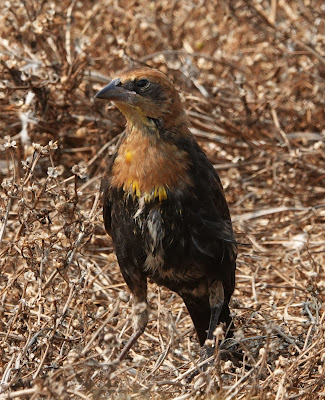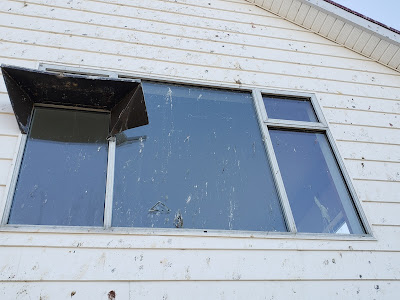When I knew that I would be spending a week at Race Rocks, one of the first things I did was draw up a wishlist of birds I might see from the island. By the end of the week, it served as the list of birds I didn't see. One of the big attractions of these offshore islands is that hungry or tired birds might stop by for a bit of rest and refueling. Race Rocks has turned up several impressive birds over the years, although most have been noted in the winter. I was excited to see what might land while I was there. I now realize that an exhausted small bird would probably end up in the belly of a gull during nesting season!
Brown Pelican was near the top of my list, and I may have seen one my first night, but it was so far away, I wasn't confident enough to include it on my list. Other no-shows included any jaegers, any phalaropes, and any shearwaters. Since my return to civilization, they have all turned up within eyeshot of the island! I guess I was just a couple of weeks too early.
Other than the gulls mentioned in the first blog about this adventure, Pigeon Guillemots were the most numerous birds at Race Rocks, some days numbering well above 100. They were all in breeding plumage, with no young. I know they nest on the island, but am quite curious about the lack of chicks. I suspect that most are lost to hungry gulls, although I did see a few sneaking fish into crevices. There may have been a few still in the nest. Besides their cute look, bright red feet and mouths, they have a very appealing "spaceship" or "laser beam" whistle that could be heard almost as constantly as the gull chatter. There were a few Double-crested and Pelagic Cormorants, mostly on the north side of the island. I suspect they will be there in much higher numbers soon as they return from their breeding sites.
 |
| Pigeon Gullemot |
At great distance, Rhinoceros Auklet, Common Murre, and one Cassin's Auklet put in appearances. None of these would have been noticed without binoculars or identified (at least by me) without a scope. On three occasions, Daniel Donnecke and I compared seawatch notes for an hour starting at dawn. Daniel was a few kilometers away at Beechey Head, but I didn't see any of the groups that he was noticing moving east during that period. Of course, there's a good chance that he was seeing birds several km out in the channel, and by the time they passed Race Rocks, they would have been farther still. The only likely duplicate was a significant group of several hundred California Gulls that left Race Rocks heading west that showed up at Beechey Head a short time later.
 |
| Distant Rhinoceros Auklet |
There were a few shorebirds as well: Black Turnstone, Black Oystercatcher (one very young), Least Sandpiper, and Western Sandpiper. There is a tiny, pebbled bay on the east side of Great Race that draws most of them, although the area of the dock is fairly popular with the shorebirds, as well. Killdeer could also be heard on the island, although only at night. A couple seemed to arrive around 9:30 pm but were gone by first light.
 |
| Black Oystercatcher with young |
 |
| Black Turnstone |
 |
| Least and Western Sandpiper |
I was honestly surprised at how few "landbirds" made their presence known during my stay. There are not a lot of hiding spots on the island, especially if you rule out gull territories. Here's the entire list:
1 Anna's Hummingbird (heading north)
1-3 Brown-headed Cowbirds (seen three times, but could have been the same individual)
 |
| Brown-headed Cowbird |
1 Feral (Rock) Pigeon
1 Song Sparrow (same bird hiding out in a wood pile away from the gulls for several days)
 |
| Song Sparrow |
1 Bald Eagle (on the rocks between Great Race and Bentinck Island)
22 Purple Martins (made 1 loop around the lighthouse and headed south)
And the bird of the week: 1 Yellow-headed Blackbird!
On my last morning, as I was doing the chores, I rounded the corner back to the house and there, on the ground, was a non-gull bird!! I immediately recognized it as a blackbird, but the colours were not what I expected. The head and breast were buffy in contrast to the darker body and wing feathers. There was also a white patch on the belly. I was pretty sure it was a Yellow-headed Blackbird, albeit a bit odd looking. Where was my camera? In the generator building, of course, where I put it while washing the solar panels. I took a couple of really bad shots with my cell phone, and retreated to get my camera. Of course, when I got back, no blackbird. After searching around a bit without any luck, I climbed the lighthouse for a view of the whole island. I could pick out Black Turnstones, so I thought I should be able to see a blackbird, too. No luck. Resigned to just having my cell photos, I returned to the house to pack up for my trip back to Victoria. Then, while I was on the phone about an hour later, I looked outside, and there he was! The call was ended, and I spent far too long and FAR too many pixels documenting this bird. The strange colour was starting to bug me, though. Could this just be another Brown-headed Cowbird? Occasionally, pale-headed varieties are seen. I'd already put the word out about the blackbird. Would I be eating crow about the ID? However, zooming in on one of the photos, I could clearly make out a few bright yellow feathers. Whew! It turns out this was a young blackbird, just going through the molt that will make him easily recognizable as a Yellow-headed.
 |
| Yellow-headed Blackbird |
That little episode cut into my cleaning and packing plans, and I barely had things wrapped up when Greg and Jeff showed up at the dock to take me back to Pearson College. Greg took over as the island's resident for the weekend, something he had not yet had the opportunity to do, while Jeff whisked me back to my regular life.
Living on a small island for a week made me think about things I often don't. In my case, these included:
- my own biological waste (the surprising volume and having to deal with it),
- how much we take a reliable energy supply for granted (and how much we use!),
- the amount of large ship traffic through the strait (easily more than 10 times as much as I would have thought),
 |
| Massive load of logs |
- how almost devoid of natural vegetation and covered in introduced grasses and plants these small offshore island are (and how impossible that might be to change when gulls and wind would constantly be reintroducing seeds from adjacent lands)
- how much foreign material/chemicals we introduce into the ocean every day
There was a sign above a sink that reminded residents that the drains went directly into the ocean. If I'd been asked to go empty a bottle of dish-washing soap into one of the bays, there is no way that I would do it, but every day, most of us do it little by little, often without a thought. Same with our detergents and microfibers from our laundry, the oils and grease we wash into our drains, and heaven forbid, the paints, caustic cleaners, and who knows what else! Our treatment plants aren't going to have much of an effect on many of these substances.
 |
| What have we put into that fish? |
In the 1970s, a saying I often heard was "The solution to pollution is dilution." It made sense to me then. But now I wonder at what point does the saturation level become toxic to life in the sea? It seems to me that we are already past that point. I don't know how we can change our course, but I left Race Rocks thinking that this may be as important an issue as climate change, but not one at the top of our minds.
The time passed very quickly, just about the point I was feeling like I was getting the hang of things. I hope I get a chance to be a relief Eco-guardian again to put what I've learned to use. Thanks, Pearson College, for the wonderful opportunity!
 |
| Pulling away from my adventure. Have fun, Greg! |













































